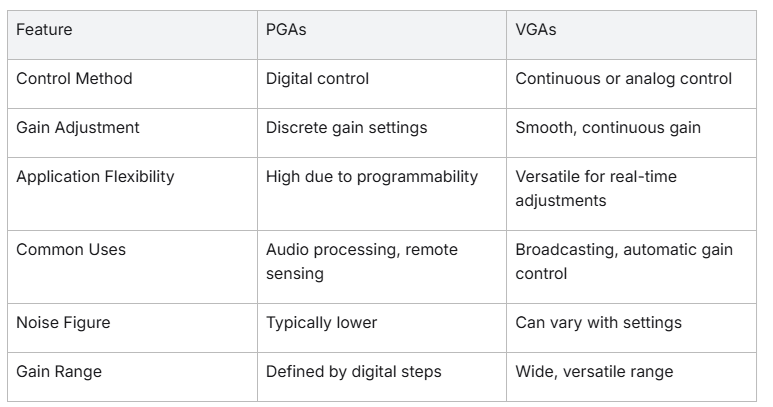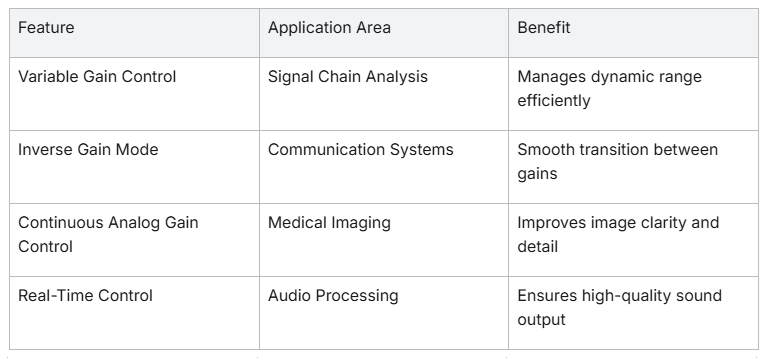The Ultimate Guide to: Variable Gain Amplifier
26/01/2025, hardwarebee
Variable gain amplifiers (VGAs) play a pivotal role in ensuring signal integrity across various industries. Their dynamic gain adjustment capability makes them indispensable for optimizing performance in diverse environments.
A variable gain amplifier is designed to modify its gain based on external control signals, providing flexibility in signal processing. This feature is critical in applications ranging from communications to medical imaging, where signal clarity impacts performance. Understanding the fundamentals and importance of VGAs sets the stage for exploring their broader implementation and advancements.
This article will delve into the key concepts of variable gain amplifiers, examine programmable gain amplifiers, discuss their applications, and highlight specific designs. By unpacking the specifications, significance, and latest advancements of VGAs, we aim to provide insight into their vital role in modern electronics and future prospects.
Key Concepts of Variable Gain Amplifiers
Variable gain amplifiers (VGAs) are crucial in managing signal levels in various electronic systems. These amplifiers allow for adjusting the amplifier gain, which is the ability to increase the power of a signal.
Definition of Variable Gain Amplifiers
A variable gain amplifier is an electronic device that adjusts its gain, or amplification level, according to a control signal. VGAs are used in systems requiring variable signal strengths, like audio and communication systems. Key features include a dynamic range and various levels of gain control, often achieving excellent gain accuracy.
Purpose and Importance of VGAs
The purpose of VGAs is to enhance signals to the desired levels without significant distortion or noise. They are essential in:
- Audio Applications: Adjusting sound levels accurately and efficiently.
- Speech Analysis: Enabling clear and distinct speech signals.
- Remote Sensing: Detecting signals accurately over long distances.
- Real-Time Adjustments: Making quick gain changes in dynamic environments.
VGAs also offer automatic gain control, allowing signals to remain stable despite fluctuations. This adapts to signal changes smoothly, ensuring consistent performance. Additionally, they can conserve power consumption by operating only when needed, contributing to the efficient functioning of electronic systems.
Programmable Gain Amplifiers (PGAs)
Programmable Gain Amplifiers, or PGAs, are devices used to adjust the amplitude of a signal. They offer precise control over signal gain, which is crucial in many electronic applications. PGAs are essential in fields like audio, remote sensing, and speech analysis. With digital control, you can fine-tune the gain to match specific needs, ensuring excellent gain accuracy and efficient power consumption.
Overview of PGAs
PGAs allow for a wide dynamic range and various levels of gain control. This adaptability makes them ideal for real-time applications where conditions can change quickly. PGAs can be programmed using a digital interface, providing users with the flexibility to adjust settings remotely. They are also designed to minimize noise figure, improving overall signal quality.
Comparison between PGAs and VGAs
Programmable Gain Amplifiers (PGAs) and Variable Gain Amplifiers (VGAs) both modify signal levels, but they differ in control methods and applications.
VGAs offer continuous gain control, making them suitable for applications needing seamless gain transitions. They are often used in situations where real-time or inverse gain mode is needed. However, PGAs provide more accurate gain control through programmable settings, which can result in more consistent performance across different applications.
Both PGAs and VGAs are essential in electronic circuits, but the choice between them depends largely on specific application needs, including power consumption, gain accuracy, and ease of use.
Applications of Variable Gain Amplifiers
Variable gain amplifiers (VGAs) are versatile components used in many electronics. They change the gain of a signal efficiently. This ability makes them useful in a range of applications, from communication systems to medical imaging.
Signal Chain Analysis
In signal chain analysis, VGAs help manage dynamic range and gain range. They allow for automatic gain control, which adjusts the signal strength in real-time. This keeps the signal within the desired range, reducing power consumption. Using VGAs ensures accurate gain control and excellent gain accuracy throughout different stages of the chain.
Applications in Communication Systems
Communication systems rely heavily on VGAs. They provide variable gain control which helps maintain clear signals even when there is interference. Inverse gain mode and continuous voltage-controlled gain are useful for smooth transitions between gains. This is essential for digital control in remote sensing and other communication tasks.
Use in Medical Imaging
In medical imaging, VGAs are crucial. They allow precise adjustments to signal gain, which enhances image quality. With continuous analog gain control, images become clearer and more detailed. This accuracy is vital for reliable diagnostics and effective treatment planning.
Role in Audio Processing
VGAs are integral to audio applications. They balance input levels for clear and quality audio output. In speech analysis, adjustable gain elements help capture natural sounding speech. VGAs also aid in essential site functionality by providing real-time control over noise figure and dB gain, ensuring superior audio processing.
Table: Key Features of Variable Gain Amplifiers
VGAs are versatile components that support various technologies by providing essential features like continuous gain control and dynamic range management.
Specific Designs and Examples
Variable gain amplifiers (VGAs) are crucial in many fields such as audio applications, remote sensing, and speech analysis. They are designed to adjust the signal gain to meet application needs. They provide dynamic range by allowing the gain to be adjusted over a wide scale. This helps in maintaining excellent gain accuracy and managing signal levels efficiently.
Overview of AD8367 X-AMP VGA
The AD8367 X-AMP is a high-performance VGA used in many essential site functionalities. It offers precise dB gain control and variable gain control, making it highly adaptable. The amplifier gain can be adjusted using a digital control, while its continuous voltage-controlled gain offers great flexibility. This amplifier is often used in real-time applications due to its low power consumption and noise figure.
Features of Automatic Gain Control (AGC)
Automatic Gain Control (AGC) is vital for maintaining consistent audio quality. It provides continuous gain control automatically, adjusting the amplifier gain to account for varying input signal levels. Features of AGC include:
– Continuous analog gain control
– Accurate gain control
– Variable gain control
– Adjustable gain element for smooth transition between gains
– Inverse gain mode for specific applications
These features help in achieving high gain range with minimal manual intervention, making AGC invaluable in audio and speech applications.
High-Performance 30GHz Variable Gain Amplifier
The high-performance 30GHz variable gain amplifier is designed for specialized tasks needing rigorous accuracy. It has a robust gain range and supports continuous gain control. This amplifier is suited for high-frequency applications demanding minimal noise figure and accurate gain adjustments. With great power efficiency, it ensures reliable performance in intense operations. It is commonly integrated with programmable gain amplifiers for dynamic and precise signal processing.
Tables and lists can be used in technical documentation to compare VGAs, illustrate their gain, power consumption, noise figure, and other specifications in a clear manner. This makes it easier for users to select the best amplifier for their specific needs.
Specifications and Features of VGAs
Variable gain amplifiers (VGAs) are essential in many applications requiring dynamic signal adjustments. They are used for their ability to manage signal gain precisely, making them ideal for audio applications, remote sensing, and real-time systems. VGAs feature digital and continuous analog gain control, allowing for accurate manipulation of signal levels. With low power consumption and excellent gain accuracy, VGAs ensure efficient performance in varied environments. They also offer features like automatic gain control and variable gain control products, ensuring flexibility and reliability in different settings.
Bandwidth and Frequency Ranges
VGAs support wide bandwidth and frequency ranges, which is crucial for applications that require high-speed data processing. These amplifiers can handle various signal frequencies, making them suitable for systems requiring quick transitions between gains. They are often used in speech analysis and audio applications where maintaining signal integrity across different frequencies is important.
Gain Control Range and Linearity
The gain control range of VGAs offers flexibility with continuous voltage-controlled gain and programmable gain amplifiers. These amplifiers provide levels of gain control, from minimal to maximum dB gain. Linearity is essential, ensuring signals remain consistent without distortion across the gain range. Accurate gain control in VGAs is vital for tasks that demand precision, such as inverse gain mode operations and maintaining a low noise figure.
Interfacing with High-Speed ADCs
Interfacing VGAs with high-speed Analog-to-Digital Converters (ADCs) is crucial for processing real-time data. VGAs ensure seamless transition of analog signals into digital form without losing quality. This capability is important for applications like essential site functionality and remote sensing. The amplifier gain and adjustable gain element work hand-in-hand to match the input requirements of ADCs, ensuring efficient data conversion and processing. Using a GAIN pin allows for straightforward integration and adjustment to achieve optimal performance in various applications.
Significance in Modern Electronics
Variable Gain Amplifiers (VGAs) play a crucial role in modern electronics. They allow devices to adapt to varying signal conditions by adjusting their gain range. This flexibility is vital in managing the dynamic range of signals. VGAs are essential in applications needing precise signal gain control, such as audio systems and real-time speech analysis. With accurate gain control, VGAs enhance performance and efficiency while reducing power consumption.
VGAs in Microwave Equipment
In microwave equipment, VGAs are indispensable due to their ability to handle high frequencies efficiently. They offer continuous gain control, which is necessary for maintaining signal integrity in microwave bands. This continuous control helps manage noise figures, ensuring clear signal transmission and reception. VGAs enhance the capabilities of microwave systems used in communication and remote sensing.
Implications for K-band and GB30000 Applications
VGAs have significant implications for K-band and GB30000 applications. Their excellent gain accuracy is crucial for applications demanding precise signal manipulation. In the K-band, VGAs help transition between gains seamlessly, maintaining consistent signal levels. In GB30000 systems, VGAs contribute to their reliability and performance, supporting essential site functionality. These amplifiers enable effective automatic gain control, making them vital for advanced communication technologies.
VGAs in Microwave Equipment
Variable Gain Amplifiers (VGAs) play a crucial role in microwave equipment. They adjust the signal gain to optimize performance. This is vital for maintaining dynamic range and reducing power consumption.
VGAs can be controlled using continuous analog gain control or digital control. This flexibility makes them essential in applications like remote sensing and speech analysis. The GAIN pin allows for precise levels of gain control, ensuring accurate and excellent gain accuracy.
A key feature of VGAs is their ability to perform automatic gain control. This allows for real-time adjustments in varying signal conditions. In microwave equipment, VGAs help in reducing noise figures and ensuring consistent signal quality.
VGAs are thus indispensable in modern microwave systems, providing accurate gain control and efficient energy usage. Whether in audio applications or speech analysis, VGAs ensure signals are transmitted clearly and effectively.
Latest Advancements in VGAs
Variable gain amplifiers (VGAs) are continuously evolving to meet modern needs. Recent advancements have improved their performance, power efficiency, and precision. For example, programmable gain amplifiers now offer more accurate gain control with less power consumption. This makes them suitable for devices that require real-time signal processing, like smartphones and remote sensing equipment.
Trends in Design and Technology
In the world of amplifier design, several trends stand out. Manufacturers are focusing on creating VGAs with wider dynamic range and gain range flexibility. This allows them to adapt to different frequency bands and maintain signal clarity. There is also a move towards integrating digital control with traditional analog systems. This offers seamless transitions between gains and enables excellent gain accuracy. Additionally, greater emphasis is being placed on reducing the noise figure. This is crucial for audio applications and speech analysis, where sound quality is important.
List of Design Trends:
– Wider dynamic range capabilities
– Enhanced gain range flexibility
– Integration of digital and analog control
– Noise figure reduction for better clarity
– Lower power consumption for extended device usage
Future Directions in Amplifier Development
The future of VGA development looks promising. One potential direction is the advancement of automatic gain control. This would allow amplifiers to self-adjust and maintain consistent signal output. Another area is increasing the capabilities of the GAIN pin for more levels of gain control. As technology progresses, we may also see more use of inverse gain mode, providing even more options for signal processing. The future could also bring about continuous voltage-controlled gain improvements, making VGAs more adaptable in various environments.
In conclusion, VGAs are on a path of innovation that promises to increase their versatility and efficiency in numerous applications.
Conclusion and Future Perspectives on VGAs
Variable gain amplifiers (VGAs) offer flexible control over signal gain, making them essential in many audio applications and remote sensing. They allow for continuous gain control and can be programmed to meet specific needs, improving both signal clarity and dynamic range.
VGAs are particularly valued for their excellent gain accuracy and low noise figure, crucial for speech analysis and real-time data processing. With technological advancements, these amplifiers are becoming more efficient in power consumption, enabling broader use in portable devices.
Future perspectives point towards even more versatile VGAs with digital control options. This development could lead to enhanced programmable gain amplifiers that offer more precise audio adjustments and automatic gain control. The industry is also exploring inverse gain modes for specific use cases, allowing for better transition between gains.
In summary, VGAs are crucial for ensuring accurate gain control. As they continue to evolve, they promise to offer improved performance across various applications, from consumer electronics to sophisticated industrial systems. This adaptability in adjusting amplifier gain indicates a robust future for VGAs in both existing and emerging technologies.













